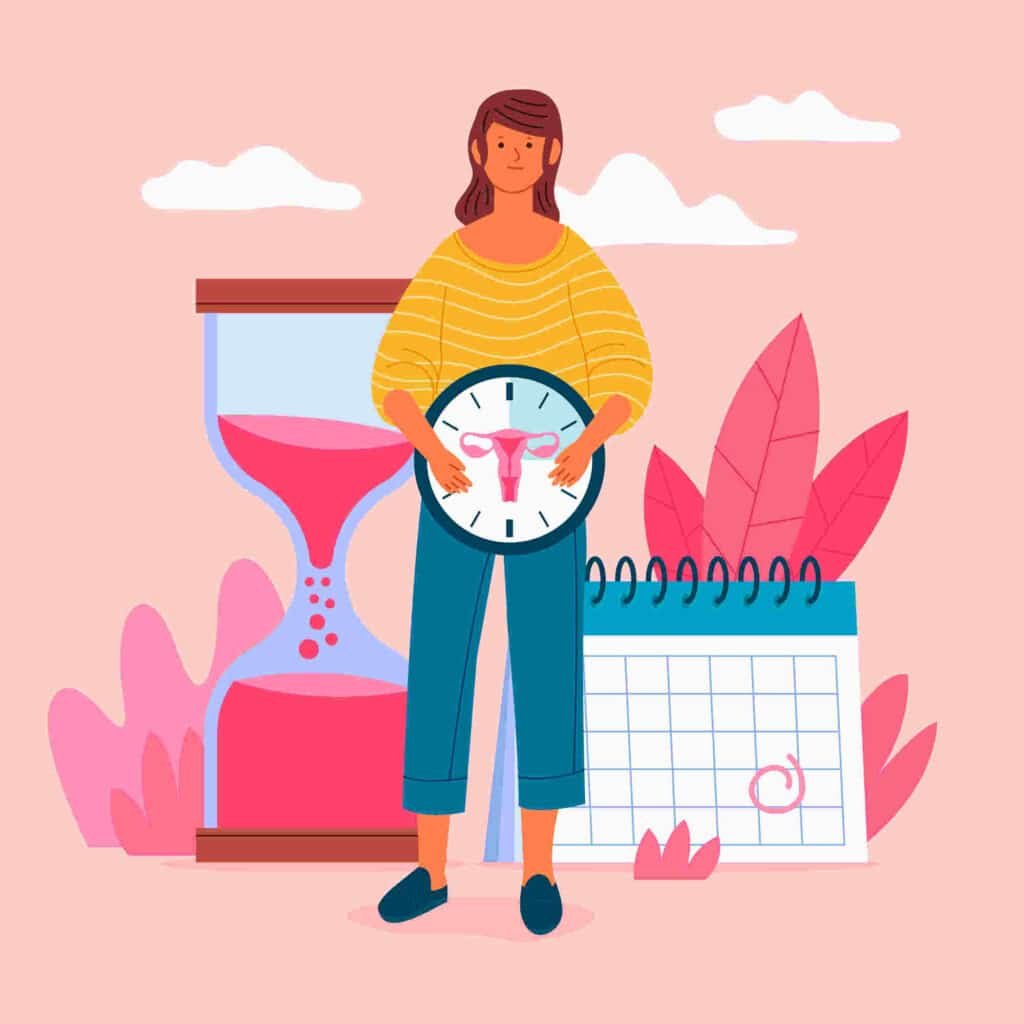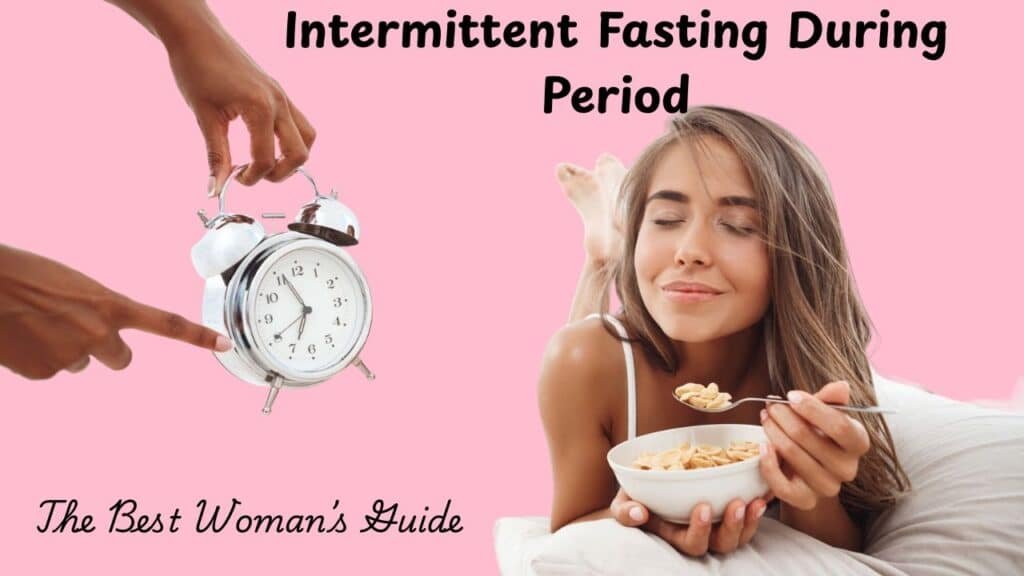Introduction
Fasting as a woman is different. However, our bodies run on rhythms. And nowhere is that more obvious than during our menstrual cycle. Hormones rise, fall, and sometimes go rogue, pulling our energy, mood, and appetite along for the ride. In the recent years, the benefits of Intermittent fasting works great. From weight loss to better insulin sensitivity, women everywhere are hopping on board, but until your period shows up. Suddenly, the hunger hits harder, energy dips lower, and your usual routine feels tougher to stick to. It makes you wonder: “Is intermittent fasting during period safe?”, or am I pushing my body too much?”

Does intermittent fasting fit into all of this?
The right answer? Yes, but only when done in sync with your cycle. This blog breaks down exactly how your hormonal changes affect fasting, the best time to fast, and when to ease off. Plus, we’ll talk about real strategies for real women. No fluff. No guesswork. Just science-backed advice, relatable tips, and body-aware guidance.
Understanding Your Menstrual Cycle – A Hormonal Symphony
Before diving into fasting regimens, let’s understand the different phases of the menstrual cycle. Why? Because each phase comes with its own set of hormonal fluctuations that directly impact how your body handles fasting.

| Phase | Days | Main Hormones | What Happens | Fasting Advice |
|---|---|---|---|---|
| Menstrual Phase | 1–5 | Low estrogen, progesterone | Bleeding, low energy, cramps, inflammation | Gentle or no fasting, focus on iron & hydration |
| Follicular Phase | 6–14 | Rising estrogen, FSH | Energy spikes, improved insulin sensitivity | Best time for longer fasts, higher workouts |
| Ovulation | ~Day 14 | LH surge, peak estrogen | High libido, high energy, hormonal peak | Optional fasting, great for 16:8 or 18:6 windows |
| Luteal Phase | 15–28 | High progesterone | PMS, cravings, mood swings, low insulin sensitivity | Shorter fasts, increase healthy fats |
Related term usage: This natural rhythm affects everything from calorie intake and insulin resistance to energy levels and stress hormone (cortisol) production.
“Women aren’t just small men. Our hormones matter.”
A study published in Obesity Reviews confirms that sex-specific hormone changes alter how we burn fat and respond to calorie restriction. Read the study here
How Intermittent Fasting Affects Periods (and Vice Versa)
There’s no denying the effect of intermittent fasting on the reproductive cycle. Some women feel stronger and more focused. Others experience irregular periods, mood changes, or even missed cycles.
What Might Happen:
- Menstrual irregularities (especially with long periods of calorie restriction)
- Drops in estrogen levels
- Fatigue or brain fog during fasted states
- Worsened PMS symptoms if nutrition is lacking
- Lower progesterone levels, disrupting the reproductive health balance
But when done mindfully, fasting can actually enhance your hormone health, improve metabolic function, and reduce chronic inflammation.
Intermittent Fasting During Period – Best Time to Practice
Let’s get to know in a way that makes sense for your body, your hormones, and your goals.
Every woman’s body is unique, but the menstrual cycle follows a general rhythm controlled by powerful hormones like estrogen, progesterone, and follicle-stimulating hormone. These hormones influence your mood, appetite, insulin response, and energy. Understanding when to fast (and when to rest) during different phases can unlock the true health benefits of intermittent fasting, without disrupting your hormonal balance.
1. Follicular Phase (Days 6–14)
This is your go-time. After your period ends, estrogen starts to climb, bringing better mood, stable energy, and increased insulin sensitivity. At this stage, your body becomes more efficient at tapping into fat stores as an energy source, helping you burn fat more effectively. This is often when the goal of intermittent fasting, such as reducing belly fat or increasing muscle mass, can be most successful.
- Why it matters: Your body is in a state of renewal. Hormonal stability helps you tolerate longer periods of time without food, triggering a natural metabolic switch that supports fatty acid utilization and metabolic repair.
- Try: 16:8 or 18:6 intermittent fasting schedule
- Ideal for: Weight loss, building lean muscle, higher intensity workouts, and focus
- Bonus: This is the best phase to test more challenging types of intermittent fasting, especially if you’re new to it.
2. Luteal Phase (Days 15–28)
Once ovulation passes, progesterone takes the lead. And so do cravings, bloating, and unpredictable moods. Your body becomes slightly insulin resistant, which means sugar and carbs can spike stress levels and worsen weight gain if not managed carefully.
- Why it matters: Your body is preparing for a potential pregnancy. This slows metabolism slightly, raises body temperature, and increases the need for more nutrient-dense food. Fasting too aggressively during this phase can backfire and throw off your natural hormonal rhythm.
- Try: Shorter fasts like 12:12, or more flexible alternate day fasting if energy allows
- Focus on: More lean proteins, healthy fats, and whole grains to support progesterone and keep hunger balanced
- Avoid: Long periods of eating restriction, intense workouts, or skipping meals for a couple days in a row
- Tip: This phase is ideal for heart health support and reducing inflammation rather than pushing fat loss hard.
3. During Period (Days 1–5)
This is your rest and reset window. Hormone levels drop to their lowest, leading to fatigue, mood changes, and blood loss. Your body is inflamed and working hard to detox and regenerate. Fasting during this time should be gentle, or skipped entirely.
- Why it matters: During menstruation, your body is focused on internal healing. Fasting can place additional stress on an already taxed system. Instead, nourish your body and let recovery take the front seat.
- Try: Listening to your body. If you’re feeling tired, don’t fast. Follow a normal eating pattern with lighter meals, or fast intuitively
- Nutrient focus: Dark chocolate, leafy greens, and essential nutrients like iron, magnesium, and omega-3 fatty acids
- Hydration tip: Replenish with electrolytes, bone broth, or coconut water to support detox and reduce cramps
- Consider: If you’ve done more intense fasting or heavy workouts in the last few weeks, this is your recovery phase. Respect it.
“Your body is not a machine. It’s a rhythm. Learn the dance.”
~Dr. Mindy Pelz, fasting expert and author of Fast Like a Girl
Explore her insights on YouTube
How Fasting Impacts Female Hormones – What the Science Says
Intermittent fasting doesn’t just change the way you eat, it changes the way your hormones behave. When it comes to a women’s body, this can be both empowering and tricky. Our hormonal system is far more sensitive to stressors like fasting than men’s. That’s not a flaw, it’s biology doing its job to protect fertility and overall balance.
In animal studies, long-term fasting reduced body weight, improved cognitive function, and lowered cortisol levels. But in women, especially those with low body fat or hormonal imbalances, too much fasting triggered menstrual irregularities.

“When women fast with their cycle, not against it, results are not just better, they’re sustainable.”
— Dr. Stacy Sims, Exercise Physiologist & Women’s Health Researcher
But when researchers looked closer at female physiology, the story became more layered. In women with low body fat or pre-existing hormone imbalances, aggressive fasting protocols disrupted ovulation, suppressed estrogen, and in some cases, halted periods entirely.
Human studies have echoed these concerns while also pointing to the benefits, if done right. A comprehensive 2022 review in the journal Nutrients concluded that intermittent fasting can reduce blood glucose, improve lipid profiles, and lower inflammation. However, it emphasized the need for a gender-aware approach, acknowledging that women respond differently due to cyclical hormone shifts.
This means your fasting routine shouldn’t be static, it should move with your cycle.
In a 2022 review published in Nutrients, intermittent fasting was shown to have positive effects on metabolic health but needed personalization for women’s bodies.
Read full research here
Real Signs You Might Be Overdoing It
Listening to your body is a lost art in the age of “pushing through.” But with fasting and female health, ignoring early red flags can come at a cost. Here are signs your fasting window might be too long, or too intense, for your hormonal state:
- Your period becomes irregular or disappears altogether
- You’re constantly cold, anxious, or fatigued
- You hit a fat loss plateau despite calorie control
- You feel wired but tired, especially in the evenings
- Sleep quality starts to suffer or cravings spiral
These aren’t just annoyances, they’re messages. Your hormones are speaking. You just have to learn the language.
To understand better you can read – Intermittent fasting and menstrual cycle
What to Eat During Fasting (and Non-Fasting) Windows
When you’re practicing intermittent fasting, what you eat during your eating window matters just as much as when you eat. This isn’t just about filling your plate, it’s about fueling your body with nutrient-dense food choices that support your hormone health and reduce unwanted side effects like cravings, fatigue, or mood swings.

We need smart food choices that actually work with your body, especially for women:
Power-Packed Food Choices for Women:
- Leafy greens – These are more than just salad fillers. They’re packed with iron and magnesium, which are key for energy, muscle health, and mood regulation.
- Lean proteins – Think eggs, fish, or tofu. These help with muscle repair and fat burning, keeping your metabolism active even when you’re not eating.
- Healthy fats – A little bit of avocado, olive oil, or a handful of nuts can go a long way. They nourish your cells and help with satiety, so you don’t feel drained.
- Whole grains – Not only do they support long-lasting energy, but they also help maintain progesterone levels, which is especially important during your cycle.
- Dark chocolate – Yes, it’s allowed! In moderation, it supports mood and provides a natural source of magnesium.
And while it might be tempting to go for quick fixes, it’s best to avoid ultra-processed foods, sugary drinks, and energy shots. They mess with your hormones and lead to crashes. Extreme calorie restriction can also backfire, especially for women.
“The magic of intermittent fasting lies in your food choices. Nutrient-dense meals during your eating window support hormone health, trigger the metabolic switch, and reduce common side effects like cravings or fatigue.”
Is Intermittent Fasting Safe for All Women?
Not always, and that’s okay. Every woman’s body is different, and it’s important to listen to what yours is telling you.
If you’re dealing with any of the following, it’s best to talk to a healthcare provider before starting intermittent fasting:
- You’ve been diagnosed with PCOS or are experiencing hormonal imbalances
- You have a history of disordered eating
- Your BMI is low or you deal with irregular periods
- You’re currently pregnant or fall under the category of menopausal women
- You’re a teen and still growing, your nutritional needs are higher and fasting may not be the right choice
Powerful Kindle read – Intermittent Fasting for Women by Patricia Nestor.
If you’ve been eating clean, staying active, and doing everything you’re “supposed” to, but the scale won’t budge or your energy feels off, this book might be exactly what you’ve been missing. Because it’s not just about calories. It’s about hormones.
Patricia Nestor’s guide isn’t another rigid diet plan. It’s a science-backed, woman-focused approach that helps you understand how your body truly works, and how to work with it. Inside, you’ll learn how to sync intermittent fasting with your natural hormonal rhythm, so fat loss becomes easier, energy comes back, and your body starts feeling like yours again.
This book replaces frustration with clarity, and guilt with empowerment. No more blaming yourself. No more one-size-fits-all rules that ignore how a woman’s body actually functions.
If you’re ready to feel better, lighter, and more confident without punishing yourself or fighting your biology, this is your moment.
Download Intermittent Fasting for Women today and discover a kinder, more effective way to reset your body, for good.
Does intermittent fasting affect periods?
Yes. It can regulate or disrupt cycles depending on fasting regimen, calorie intake, and hormonal sensitivity. Go slow and track your cycle.
What’s the best time to fast during the menstrual cycle?
The follicular phase is the best time. Your body handles insulin better, and energy levels are higher.
Can fasting worsen PMS symptoms?
Yes, especially if paired with low calorie intake or lack of nutrients. Eating more healthy fats and leafy greens can help.
Is it okay to fast while on your period?
It’s safe if you feel good, but listen to your body. Rest days and nourishing meals are more important than pushing through fatigue.
Can fasting help with hormonal balance?
Yes, if done correctly. It may improve insulin resistance, reduce chronic inflammation, and support hormone levels when aligned with your cycle.
“Fasting can be a powerful tool, but it should empower your cycle, not fight against it.”
~Excerpt from GuudWoman’s guide on women & fasting
Your Intermittent Fasting Plan for the Whole Cycle
Every woman’s cycle comes with its own rhythm, and your intermittent fasting plan should flow with it, not fight it. Honoring each phase of your cycle helps support your energy, hormones, and mood in a smarter, more sustainable way.

| Cycle Phase | Fasting Window | Intensity | Focus |
|---|---|---|---|
| Menstrual | None or 12:12 | Low | Gentle recovery, rest, and iron intake |
| Follicular | 16:8 or 18:6 | High | Peak energy for fat burning, workouts, and mental clarity |
| Ovulation | 16:8 | Moderate | Build strength, support metabolism, and maintain balance |
| Luteal | 12:12 or 14:10 | Low | Focus on mood support and reducing cravings with mindful eating |
“Fasting in sync with your cycle isn’t a trend, it’s biology. When you align your fasting window with your hormonal shifts, you support fat burning, reduce stress on the body, and unlock deeper, long-term health benefits.”
Tips to Make Fasting Cycle-Smart
Here are a few powerful ways to sync your fast with your body’s natural rhythm, these aren’t rules, just reminders that make a big difference:
Track your cycle – Apps like Clue or Flo can help you spot patterns and know when to ease up or push forward.
Notice mood swings – Cravings, emotional shifts, and sleep patterns can all signal how well your hormones are coping with fasting.
Prioritize electrolytes – Especially in a fasted state, they help prevent fatigue, headaches, and that sluggish “crash” feeling.
Break your fast with your first meal – Choose something rich in protein and healthy fats to support hormone balance and satiety.
Move gently during your period – Swap high-intensity workouts for yoga, stretching, or calm walks when your body needs rest.
Stick to normal eating patterns – On non-fasting days, eat mindfully and consistently to keep your metabolism and hormones happy.
Align Fasting with Your Flow
The main reason behind intermittent fasting diets for women isn’t just about cutting calories, it’s about connection. When you align fasting with your hormonal cycle, you’re not restricting your body, you’re respecting it. Your cycle isn’t something to fight against. In fact, it holds the key to unlocking the full benefits of fasting.
There’s now much research showing that syncing your fasts with your reproductive rhythm can lead to significant changes in how your body responds, especially when it comes to levels of insulin, energy use, and long-term fat metabolism. It’s not just about short-term weight loss. It’s about supporting your body’s natural flow for long term good health.

Think of your hormones as messengers in every part of the brain, from appetite control to mood, to sleep and stress. When you fast without considering your cycle, the effects of intermittent fasting may feel harder. But when you adjust with intention, you amplify the potential benefits, from stable energy to reduced risk of heart disease. Your body already knows what it needs. You just have to listen, and honor it.
If you’re looking for a personalized intermittent fasting plan or want to explore different ways to adjust based on your hormone levels, start by syncing with your reproductive cycle. Let fasting become a partner in your long-term weight management, metabolic health, and good health. Over a period of time, this kind of alignment can turn fasting from a struggle into a strategy, one that supports your hormones, your metabolism, and your sense of well-being.
Let fasting become a supportive rhythm, not a strict rule.



